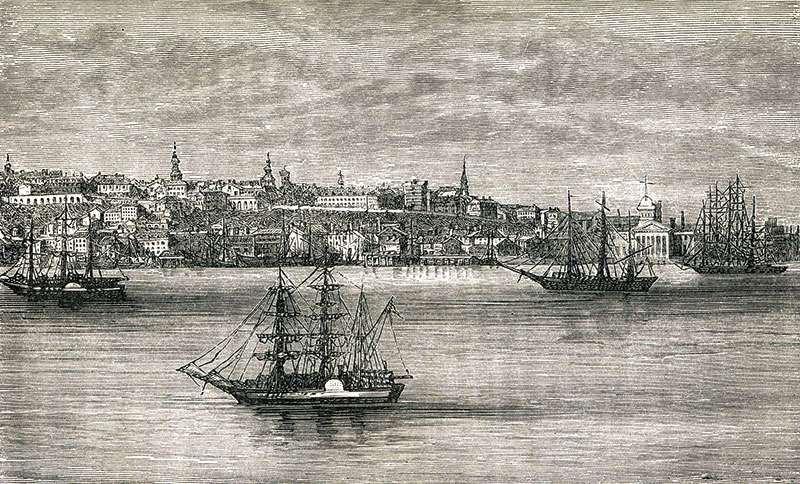That Sinking Feeling

Un texte de Heather Darch
Paru dans le numéro Hiver/Winter 2023-2024
Publié le : 8 novembre 2023
Dernière mise à jour : 10 novembre 2023
At its launch in 1750, the warship L'Orignal was a total loss because she was made from “inferior wood” cut in the forests of Saint-Armand.
It was a festive September day in 1750 when hundreds gathered at Quebec’s shipyard to witness the launch of the largest warship in the King’s service. The Orignal (The Moose) was a 62-gunned ship with the potential to carry more. Considered invincible, weighing 1000 tons and stretching over 47 metres, she was made of oak, red pine and cypress selected by the Master Shipbuilder René-Nicolas Levasseur himself. The joyful atmosphere was short-lived. According to reports, the ship slid too quickly into the water and was carried away by its momentum and the current. The mooring cables, tied improperly, could not control her speed and with the anchors dropped in place, she tore in half. While the accident would have caused serious damage to any ship, the Orignal was a total loss because she was made from “inferior wood” cut in the forests of Levasseur’s own Seigniory of Saint-Armand on Missisquoi Bay.
Quebec’s shipbuilding heritage dates from the French regime, beginning as a modest enterprise at the mouth of the Rivière Saint-Charles, in the early 1600s. A lack of workers and knowledge for building warships meant that shipbuilding was not expanded until the mid-century arrival of professional shipwrights from France.
Following a 1713 peace treaty between France and Britain, there was an expansion in inter-colonial trade that resulted in a rapid growth of shipbuilding and heightened the need for a skilled administrator to govern the shipyard. In 1738, France sent René-Nicolas Levasseur (c. 1705-1784) whose family was linked to shipbuilding for almost a century. One of his many tasks as Superintendent of Shipyards was to personally survey forests to verify the quantity and quality of the wood needed for warships. So efficient was his management, he was awarded “the whole fief and seigniory of Saint-Armand on Missisquoi Bay and Lake Champlain.” Here, Levasseur marvelled at the thick stands of oak and red and white pine and quickly established a sawmill on Abenakis territory along the “Missiskoui River.” By 1749, timber from his sawmill was shipped down the Richelieu and St. Lawrence Rivers to Quebec.
There were “red flags” early on in his Saint-Armand enterprise. The forest resources could not support the length of timber required for large vessels. Levasseur considered the trees to be mediocre and better suited for smaller merchant vessels weighing 300 tons, but to meet the increase in demand for the building of war vessels, he pushed his luck and used his seigniory’s forest.
With a larger colonial shipyard established at Cul-de-Sac on the Saint Lawrence; replacing the shipyard at Rivière Saint-Charles, construction of large naval vessels became more ambitious. Levasseur fancied a warship built every two years and a dozen merchant ships and many small service vessels besides. An agricultural crisis beginning in 1742 however, led to a rise in prices; forcing smaller secondary industries in pitch and tar for caulking and flax and hemp for ropes and sails, to collapse. Levasseur had to order essential parts from France for the completion of the vessels and when the peace treaty failed and the English navy began to block the entrance to the St. Lawrence, the survival of the shipyard was threatened. Following the disaster of the Orignal, Levasseur was still able to build the Algonquin in 1753, the Abénaquisein 1756 and the frigate Québec; a ship never completed as the shipyard was abandoned when the British seized Quebec.
From the arrival of the first King’s shipwrights to 1759, the government of New France had built over 230 vessels. After the Conquest, shipbuilding resumed with many Scottish shipbuilders moving to Quebec for work. Quebec’s shipyards turned out 1600 wooden sailing vessels between 1763 and 1893 to meet the demand of Britain’s merchant navy. The shipyards stood fifth in the world for the tonnage that floated into its wharves. This “gateway to North America was a bustling hive of noise and smells, and languages and trade” as the great sailing vessels, laden with supplies and settlers bound for Quebec, came into its port. The development of additional shipyards employed thousands of artisans and labourers drawn from Quebec’s own citizens as well as the Irish, Scottish and English communities.
Levasseur returned to France in 1760, selling his seigniory to a London merchant before he left. The trees in Saint-Armand continued to be used for the construction of buildings, fencing, bridges, roads and potash businesses, but were never again utilized for large shipbuilding.
Heather Darch
Sources
Ronald Portanier, Shipbuilding in New France, www.art-history-shipbuilding.hybrid.concordia.ca/Essays/shipbuilding-in-new-france.pdf
Real Brisson. La Charpenterie Naval à Québec sous le régime Français. Québec : Institut Québécois de Recherche sur la Culture, 1983.
Eileen Reed Marcil, The Charley-man, A History of Wooden Ship Building at Quebec from 1763 to 1893, 1995.
David Plouviez. The Maintenance, repair and construction of ships in the French Empire during the eighteenth century. International Journal of Maritime History, SAGE Publishing, 2019, 31 (3), www.halshs.archives-ouvertes.fr/halshs-03362209/document
Rénald Lessard, Construction navale royale à Québec, 1739-1759 : des navires et des hommes in L’Ancêtre, 308, (41), pp. 63–65, automne 2014.
René-Nicolas Levasseur, www.biographi.ca/fr/bio/levasseur_rene_nicolas_4F.html
Missisquoi Loyalists, Vermont History Society www.vermonthistory.org/journal/misc/MissisquoiLoyalists2.pdf

